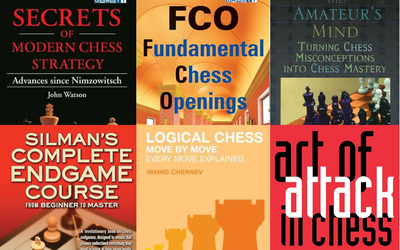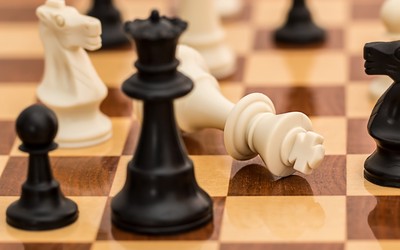
How I finally earned a FIDE rating
After a disappointing tournament, I bounced back even strongerDespite playing in over-the-board tournaments for over two years, it is only now, after my 10th tournament, that I have finally earned a FIDE rating. To get a FIDE rating, you need a rating of at least 1000 and to play against five other players with a FIDE rating. As there has been such a large influx of new players since Covid, almost none of my opponents until now had FIDE ratings.
Although I had a disappointing performance in Drogheda, my victories against players hundreds of points higher than me in the Killane Shield gave me a strong confident boost. I knew I could play at a higher level and as the 18th ranked out of 21 players, I felt the only way I could go was up.
The tournament was organised by the Catholic University School, which is an unusual name for two reasons. Firstly, it's not a university, it's a secondary school. Secondly, almost all schools in Ireland are Catholic, so it's unnecessary to state this in its name. Also the students wear blazers as part of their uniform, a sign that this is one of those elite private schools I could only set foot in as part of a chess tournament.
Revenge is best served slowly
By coincidence, my first round opponent was the same person I played in the first round of the Drogheda Congress. As I felt I should have won that game, I was eager to get my revenge. As in that game, he played slowly and I quickly built up a large time advantage, but I made sure not to repeat the same mistake as last time. I didn't play recklessly or hastedly but instead took my time.
My opponent took me by surprise on move 2 by playing f6, which I had never seen before. In fact, of Black's first 8 moves, 6 were on the f-file. I found this very unusual and a rough rule of thumb for chess is that if an opening is rarely played, there's usually a good reason for this. However, I couldn't see anyway to immediately punish it, so instead I was content to develop my pieces and build up a time advantage.
With Black's pawns marching down the kingside, I felt I had to castle queenside. Otherwise, I wasn't too worried about the position, Black might be pushing his pawns, but his pieces were not well-developed and were blocking each other. There seemed to be little potential for him to mount an attack.
The position was locked, with little chance for a break through for either side, which normally would have frustrated me, but I had a huge time advantage. My opponent would spend huge amounts of time on each move, which meant that by this time he had only 10 minutes left, whereas I still had an hour. Thus, I felt no pressure to break open the position or to try and force a win. Let him use up what little time he has left on trying to figure a way to break through or launch a reckless attack, I can afford to wait.
Perhaps this is why Black sacrificed a Bishop on move 19, a tactic that didn't seem to give him any advantage. He began pushing hard on the kingside, but I felt I could hold him off. His time was so low that he was playing entirely on increment yet on move 31, he let his clock run down to only 2 seconds before retaking with a pawn, a move I would have made instantly.
With all his focus on the kingside, I saw an opportunity to attack on the undefended queenside. The only question was which piece should the lead the attack? The Queen or one of the knights? All I needed was two moves and then I would be winning, but what if he counter-attacked in the one move before my blow landed? I was afraid of Rook to f1 on move 32 (and the engine says it destroys my chances) and even considered leaving the Knight undefended to go on an attack. Instead, I got lucky and was able to break open Black's defences.
Once I started giving checks, I knew I had won. I chased the king across the board, picking up pawns and finally an exchange. The last hope for Black was to block the f-file with Rook to f2 on move 38, but that would have only delayed the inevitable. Up a Knight and with two passed pawns, I had won.
Might as well go out swinging
Round 2 was the toughest game of the tournament as I played an opponent who would go on the win the event. My opponent opened with the Petrov Defence, but instead of taking on e5 like I always do, I decided to defend e4 with my Knight. I guess my logic was I should surprise everyone, including myself.
The first 12 moves were pretty standard, until my opponent played g5. I normally would just retreat with my Bishop, but instead I decided to sacrifice my Knight to destroy the King's defences. I knew it was risky but I thought the vulnerability of the King would pay off. When playing higher rated players, it is tempting to play defensive and let them try to come up with a plan, but I didn't want to abdicate the initiative to him and just wait to see if I would lose. I would probably lose anyway, so I might as well go out swinging.
Unfortunately, my attack didn't have enough supporting pieces and as I tried to add pressure, I made a blunder. My opponent saw a clever tactic where they could take my Bishop on move 17, because although they lose their Queen, I also lose mine.
The situation seemed dire and the only way out seemed to be to give a double check to prevent either piece from getting taken. My hopes started to rise and I thought this brought me back into the game as wherever the King went, my Queen would have a very strong attack. However, the one move I hadn't considered was that the King could take my Bishop.
After this, the game was basically over. I was still in shock from losing two pieces in two moves, so I kept playing, but my opponent quickly found some nice combinations to end my misery.
Endgame training pays off
My round 3 game began with the English opening and I responded by also using my c-pawn to exert influence on the centre. White traded their Knight for my Bishop, which I was happy to accept as it gave me more control over the centre and my Bishop was doing very little anyway. I steadily pushed forward, damaged the opponent's King's defences and eventually won a pawn.
At the time I was feeling confident, but the engine says I had actually blundered and it wasn't until the Queens were exchanged that I was winning. I probably should have tried to hold on to my pawn on c3, but I was afraid of White doubling their Rooks and checking me on the f-file. Either way, the game settled into a Rook and pawn endgame where I had a one pawn advantage.
I've recently been studying endgames and while I am still very far from mastering it, I felt my study paid off in this game. I knew I had to bring my King over to where I had a pawn majority and escort my pawns slowly to the finish line. While my technique wasn't flawless, I was able to stay calm and confident in the position (although a5 on move 47 did stress me). In endgames it's easy to go frustrated and feel you are making no progress or be uncertain of what progress would even look like, but I was able to stay focus even if it would take dozens of moves to convert my position into a win. So when my opponent offered a draw on move 51, I quickly declined, because I knew I was winning.
I was surprised when my opponent offered a Rook trade on move 56 because without the Rook, they would have no way to stop my pawn from promoting. However, it was also true that I had no way to stop their h-pawn from promoting. Our Queens would promote around the same time so I would still be winning but I was afraid of a situation where my opponent gives me dozens of checks as our Queens dance across the board. I was about to win a pawn regardless, so it seemed safer to keep the Rooks as a two pawn lead would certainly bring me victory.
My endgame training paid off as I was able to dance my King and pawn forward to the end and prepared to finally use my Rook to block White's Rook. Promotion couldn't be stopped, so my opponent resigned. Afterwards, my opponent said he thought the endgame could have been drawn, but I knew better.
It's so over - I'm back
Some chess games slowly develop as you gradually improve your position little by little. In other games, an attack begins before you have time to put your shoes on and before you know it, you're fighting for your life. This game began with my opponent playing the Smith-Morra Gambit in response to my Sicilian and the quick development gam them an early advantage. Before I knew, I was surrounded by danger, struggling to hold on to my pawn and my whole position. I knew the situation was bad, but I didn't know it was +7 for my opponent on move 12.
All I needed was one or two moves of breathing space to defend and castle and then I would be fine, but would I get it? Had my opponent kept the pressure on and taken the pawn on d6, I would have been in trouble (the engine shows a tactic that completely destroys me). But by moving the Rook to c1, I had that one precious turn to ease the pressure. At first, I was willing to trade the pawns, but then I remembered my Queen was on that diagonal, so I was actually winning a pawn.
When my opponent took on move 16, I was surprised. I attentively scanned the board for some unforseen danger, some devastating tactic I had missed. I couldn't see anything so I hesitantly took the Knight. As my opponent took 40 minutes to make their next move, I felt confident things weren't going to plan for him..
After all the stress and pressure, my opponent cracked and began sacrificing everything they had. First it was a Rook for a Knight, then they pinned their Knight to their Queen allowing me to win it. In only 5 moves, I went from completely lost to completely winning. I was +7 in material and White had few pieces left to try to get any counter play so they resigned. Afterwards, my opponent said at least I didn't have a FIDE rating, so they didn't lose any points. That would soon change.
I don't have to win, to win
Before the last game begun, I had already won. My aim had only been to score 2/5 in this tournament, anything above that was a bonus. As I already had 3 points, including a win against someone 100 points stronger than me, I felt I had won no matter what the outcome of the last game. This was in contrast to Drogheda where a poor start had made me reckless in later games. When added with the fact that my opponent was more than 200 points higher rated than me, I felt no urge to take any risks.
That being said, I was still going to play for any advantage I could find. After a nice Ponziani opening, I doubled Black's pawns on the c-file and this became my target. At one point my advantage was +3, but the precise winning moves were hard to see. On move 24, I debated moving my Knight to d4 or my Rook to c1 to pressure the c6 pawn. Unfortunately, I made the wrong choice. I presumed b3 would simply kick the Knight away, but I missed that it cuts off my defence of the Rook. As my Rook was isolated, I felt I had no choice but to exchange it for the Knight.
I was down a pawn, but I didn't lose hope. I have been in endgames like this before and I knew how hard it can be to convert this into a win. Many times I had seen these positions turn into draws after endless shuffling of Queens. With only a Queen and a Rook, it is difficult to launch an attack without leaving your King undefened. I just had to stay calm and keep it safe.
This is what I did, keeping my pieces close to my King and only venturing out to check Black's King. Pushing the pawn to g6 on move 42 intrigued me - was this a weakness I could exploit? Was there some way I could get my Queen and Knight to team up for an attack? I spent a long time mulling over the position, but I couldn't find any killer move. I didn't want to risk it all, so instead I offered a draw. My opponent declined, but after the next move, accepted.
Fact or FIDE?
Something I found very unusual was the massive difference between ratings given by the Irish Chess Union and those given by FIDE. Most players had hundreds of points of difference between their two ratings, to the point that the FIDE rating seemed to give little indication of someone's actual strength.
To illustrate the difference, here are the ratings of my five opponents:
| Round | ICU | FIDE |
| 1 | 1161 | 1536 |
| 2 | 1430 | 1573 |
| 3 | 1114 | 1495 |
| 4 | 1287 | 1477 |
| 5 | 1385 | 1739 |
Conclusion
Despite being one of the lowest ranked players in my section, I finished 4th, only half a point off the three players who jointly won. I did, however, win a grading prize of €50. Even more valuable was the 75 ICU rating points I gained, lifting me to a new high of 1235 after a performance of 1435. It's amazing to see how far I have come this year. When I competed in the CUS Congress last year, I increased my rating from 885 to 906, one year later, I am 300 points higher rated.
And best of all, I finally got a FIDE rating. Not only that, but it's the very impressive rating of 1503, after a performance of 1604. This makes me the 441st best active chess player in Ireland and in the top 100,000 globally.
More blog posts by TeoKajLibroj

Irish Chess Union gives massive rating boost to Irish chess players
How I gained 400 points without playing a game
6 chess books I tried to read
And which ones I would recommend
Has the chess boom reached OTB tournaments?
Have Irish tournaments experienced the chess boom?
